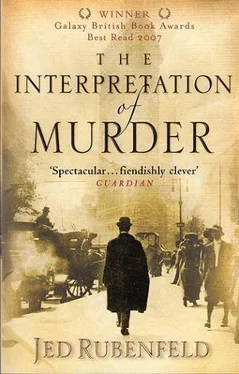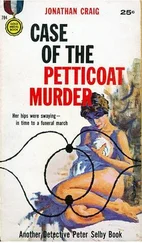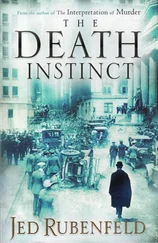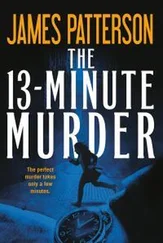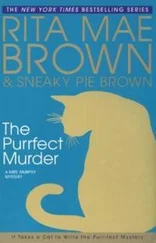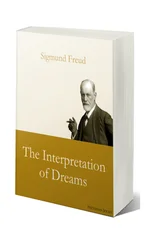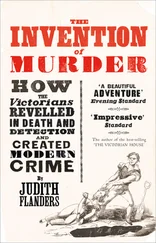Jed Rubenfeld - The Interpretation of Murder
Здесь есть возможность читать онлайн «Jed Rubenfeld - The Interpretation of Murder» весь текст электронной книги совершенно бесплатно (целиком полную версию без сокращений). В некоторых случаях можно слушать аудио, скачать через торрент в формате fb2 и присутствует краткое содержание. Жанр: Исторические приключения, на английском языке. Описание произведения, (предисловие) а так же отзывы посетителей доступны на портале библиотеки ЛибКат.
- Название:The Interpretation of Murder
- Автор:
- Жанр:
- Год:неизвестен
- ISBN:нет данных
- Рейтинг книги:5 / 5. Голосов: 1
-
Избранное:Добавить в избранное
- Отзывы:
-
Ваша оценка:
- 100
- 1
- 2
- 3
- 4
- 5
The Interpretation of Murder: краткое содержание, описание и аннотация
Предлагаем к чтению аннотацию, описание, краткое содержание или предисловие (зависит от того, что написал сам автор книги «The Interpretation of Murder»). Если вы не нашли необходимую информацию о книге — напишите в комментариях, мы постараемся отыскать её.
The Interpretation of Murder — читать онлайн бесплатно полную книгу (весь текст) целиком
Ниже представлен текст книги, разбитый по страницам. Система сохранения места последней прочитанной страницы, позволяет с удобством читать онлайн бесплатно книгу «The Interpretation of Murder», без необходимости каждый раз заново искать на чём Вы остановились. Поставьте закладку, и сможете в любой момент перейти на страницу, на которой закончили чтение.
Интервал:
Закладка:
Officer Reardon was no longer keeping an eye on Chong Sing. Instead he was close to passing out. Seeing this, Chong slipped back into the crowd of murmuring Chinese and out the open door.
We trudged silently up the four flights of stairs to Brill's apartment, each of us wondering, I assume, how to respond to the difficulties in Worcester. We had several hours to spend before a dinner party to which Smith Jelliffe, Brill's publisher, had invited us. At the fifth-floor landing, Ferenczi commented on a peculiar smell of burning leaves or paper. 'Someone is maybe cremating a dead person in their kitchen?' he suggested helpfully.
Brill opened his door. What we saw inside was unexpected.
It was snowing inside Brill's apartment — or seemed to be. A fine white dust drifted about the room, swirling in the air currents created by our opening the door; the floor was covered with the stuff. All of Brill's books, together with the tables, windowsills, and chairs, were coated. The smell of fire was everywhere. Rose Brill stood in the middle of the room with broom and dustpan, covered head to foot in a white rime, sweeping up as much as she could.
'I just got here,' she cried. 'Shut the door, for heaven's sake. What is it?'
I gathered some in my hands. 'It's ash,' I said.
'You left something cooking?' Ferenczi asked her.
'Nothing,' she answered, brushing the white grains from her eyes.
'Someone put it here,' said Brill. He wandered about the room in a trance, his hands outstretched before him, alternately grabbing at the ash and waving it away. Suddenly he turned to Rose. 'Look at her. Look at her.'
'What is it?' asked Freud.
'She's a pillar of salt.'
When Captain Post arrived with reinforcements from the West Forty-seventh Street station, he ordered — over Detective Littlemore's objections — the arrest of a half dozen Chinese men at 782 Eighth Avenue, including the manager of the restaurant and two patrons who had the misfortune to come upstairs to see what the commotion was. The body was carted off to the morgue and a double manhunt begun.
Littlemore's first thought was that he had found Elizabeth Riverford's missing corpse, but there was too much decomposition. He was no pathologist, but he doubted Miss Riverford, murdered on Sunday night, could have putrefied so thoroughly by Wednesday. Mr Hugel, thought Littlemore, would know for sure.
Meanwhile, the detective went through the letters he had found inside the trunk. They were love letters, more than thirty of them. All began Dearest Leon; all were signed Elsie. Neighbors differed on the name of the room's inhabitant. Some called him Leon Ling; others said he went by William Leon. He managed a Chinatown restaurant, but no one had seen him for a month. He spoke excellent English and wore only American suits.
Littlemore examined the photographs hanging on the walls. The building's occupants confirmed that the man in the pictures was Leon, but they did not know or would not say who the women were. Littlemore noticed that every single woman was white. Then he noticed something else.
The detective took down one of the photographs. It showed Leon standing, smiling, between two very attractive young women. At first the detective thought he must be mistaken. When he was convinced he was not, he put the picture into his vest pocket, made an arrangement to meet Captain Post the next day, and left the building.
The late afternoon air was still uncomfortably hot and muggy, but it was like a heavenly garden compared to the chamber from which Littlemore emerged. It was just past five when he got to Betty's apartment. She wasn't home. Her mother tried frantically to make the detective understand where 'Benedetta' was, but as the woman was speaking Italian, and rapidly at that, he could make neither heads nor tails of it. At last, one of Betty's little brothers came to the door and translated: Betty was in jail.
All Mrs Longobardi knew — because a nice Jewish girl had come to tell her — was that there had been trouble at the factory where Betty started work today. Some of the girls had been taken away, including Betty. 'Taken away?' asked Littlemore. 'Where?'
The mother didn't know.
Littlemore ran to the Fifty-ninth Street subway station. He stood all the way downtown, too worked up to take a seat. At police headquarters, he learned that strikers had hit one of the big garment factories in Greenwich Village, picketers had started smashing windows, and the police had arrested the worst couple dozen of them to clear the streets. All the rowdies were now in jail. The men were being held in the Tombs, the girls at the Jefferson Market.
Chapter Fourteen
In the 1870s, a fanciful profusion of Victorian high Gothic sprang up on a triangular plot of land at the corner of Tenth Street and Sixth Avenue, contrasting incongruously with the otherwise disreputable workingman's neighborhood. The new polychromatic courthouse was a jumble of steeply sloping roofs, with gables and pinnacles jutting out at every height and angle; its watchtower was crowned by a 170-foot turret. A five-floor prison in the same style was attached to this courthouse, and to the jail was attached another grand edifice, which housed a marketplace. Collectively, the place was known as Jefferson Market; the conceit was that institutions of law and order ought not to be sequestered from those of daily life.
By day, criminal cases of great import were tried in the Jefferson Market courthouse. After hours, the same tribunal became the city's Night Court, where vice cases were processed. As a result, the Jefferson Market jail was occupied largely by prostitutes awaiting disposition and punishment. It was here, in this jail, that Littlemore found a frazzled but unhurt Betty on Wednesday evening.
She was in a large, crowded holding cell in the basement. Some twenty-five or thirty women were detained within, standing in small knots or sitting on long narrow benches against the walls.
The cell was divided between two classes of prisoner. There were about fifteen young women in working outfits like Betty's — simple dark, solid-colored skirts, down to their ankles, of course, and white long-sleeved blouses. These prisoners were from the shirtwaist factory where Betty had for half a day been an employee. A few of these girls were as young as thirteen.
Their colleagues were another dozen women, of various ages and far more colorful in their accoutrements and cosmetics. Most were loud and conspicuously at their ease, being familiar with the surroundings. One, however, was louder than the others, complaining to the guards and demanding to know how a woman in her circumstances could be kept in jail. Littlemore recognized her at once; it was Mrs Susan Merrill. She was the only one with a chair, which the others had deferentially yielded to her. Over her shoulders was a burgundy wrap, in her arms a baby, sleeping peacefully despite the uproar.
Littlemore's badge got him inside the jailhouse, but it couldn't get Betty out. They stood only a few inches from each other, separated by the floor-to-ceiling iron bars, speaking quietly. 'Your first day of work, Betty,' Littlemore said, 'and you went on strike?'
She had not gone on strike. When Betty arrived at the factory that morning, she went directly to the ninth floor and joined a hundred other girls sewing. There were, however, at least fifty empty stools in front of idle sewing machines. What had happened was this: the day before, a hundred fifty seamstresses had been fired for being 'union sympathizers.' That evening, in response, the International Ladies Garment Workers Union called a strike against Betty's factory. As the next morning wore on, a small band of laborers and unionists gathered in the street below, shouting up to the workers on the floors above.
Читать дальшеИнтервал:
Закладка:
Похожие книги на «The Interpretation of Murder»
Представляем Вашему вниманию похожие книги на «The Interpretation of Murder» списком для выбора. Мы отобрали схожую по названию и смыслу литературу в надежде предоставить читателям больше вариантов отыскать новые, интересные, ещё непрочитанные произведения.
Обсуждение, отзывы о книге «The Interpretation of Murder» и просто собственные мнения читателей. Оставьте ваши комментарии, напишите, что Вы думаете о произведении, его смысле или главных героях. Укажите что конкретно понравилось, а что нет, и почему Вы так считаете.
